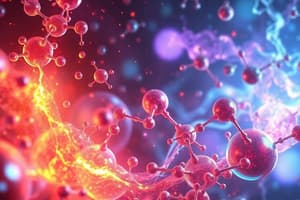Podcast
Questions and Answers
The rate of the reaction 2 NO(g) + O(g) = 2 NO₂(g) is expressed as Rate = k[NO][O], indicating the reaction is _____ order.
The rate of the reaction 2 NO(g) + O(g) = 2 NO₂(g) is expressed as Rate = k[NO][O], indicating the reaction is _____ order.
3rd
For the reaction H₂ + I₂ = 2 HI, the rate law is Rate = k[H][I], making it a _____ order reaction.
For the reaction H₂ + I₂ = 2 HI, the rate law is Rate = k[H][I], making it a _____ order reaction.
2nd
The total reaction order for H₂ + B₂ = 2 HBr is _____ .
The total reaction order for H₂ + B₂ = 2 HBr is _____ .
1.5
Molecularity refers to the number of _____ of reactants in the balanced equation.
Molecularity refers to the number of _____ of reactants in the balanced equation.
In the reaction 2NH₃ = N₂ + 3H₂, if the order with respect to A is zero, it indicates that the concentration of A does not affect the _____ of the reaction.
In the reaction 2NH₃ = N₂ + 3H₂, if the order with respect to A is zero, it indicates that the concentration of A does not affect the _____ of the reaction.
Zero order reactions occur when the surface of the catalyst becomes _____ by the reactant molecules.
Zero order reactions occur when the surface of the catalyst becomes _____ by the reactant molecules.
The unit of k for a first order reaction is _____ .
The unit of k for a first order reaction is _____ .
The overall reaction order is the sum of the powers of the _____ in the rate law expression.
The overall reaction order is the sum of the powers of the _____ in the rate law expression.
For more complex reactions, we must be careful in writing the rate ______.
For more complex reactions, we must be careful in writing the rate ______.
Two moles of A disappear for each mole of B that ______.
Two moles of A disappear for each mole of B that ______.
The rate of disappearance of A is twice as fast as the rate of appearance of ______.
The rate of disappearance of A is twice as fast as the rate of appearance of ______.
Molecularity has integral values only (1, 2, 3, ...), while the order can have ______ values.
Molecularity has integral values only (1, 2, 3, ...), while the order can have ______ values.
The sum of the powers of the concentration terms of reactants in the rate law expression is called the ______.
The sum of the powers of the concentration terms of reactants in the rate law expression is called the ______.
A reaction is zero order in a reactant if the change in concentration of that reactant produces no ______ on reaction rate.
A reaction is zero order in a reactant if the change in concentration of that reactant produces no ______ on reaction rate.
A reaction is 1st order if doubling the concentration causes the rate to ______.
A reaction is 1st order if doubling the concentration causes the rate to ______.
A reaction is 2nd order if doubling the concentration causes a ______ increase in rate.
A reaction is 2nd order if doubling the concentration causes a ______ increase in rate.
Flashcards are hidden until you start studying
Study Notes
Reaction Rates and Order
- The rate law expresses the relationship between the rate of a reaction and the concentration of its reactants.
- Example: For the reaction 2NO(g) + O(g) → 2NO₂(g), the rate law is Rate = k[NO][O], indicating a third-order reaction.
- Example: For H₂ + I₂ → 2HI, the rate law is Rate = k[H][I], classified as a second-order reaction.
- For H₂ + Br₂ → 2HBr, the overall rate expression is Rate = k[H][Br₂], with a total order of 1.5.
Molecularity
- Defined as the number of molecules of reactants involved in the rate-determining step.
- Molecularity is always an integer and cannot be zero or a fraction; can theoretically range from 1 to 3 or more.
- Example: In the reaction 2NO + Cl₂ → 2NOCl, the molecularity is 3.
- Actual molecularity may differ from stoichiometry due to intermediate species or complex mechanisms.
Order of Reaction
- The order of a reaction is derived from the powers of the concentration terms in the rate law.
- Reaction order can be zero, first, or second:
- Zero order: Rate is unaffected by the concentration of the reactant (e.g., NH₃ decomposition in the presence of Pt).
- First order: Doubling the concentration doubles the rate.
- Second order: Doubling the concentration results in a quadruple increase in rate.
- Reaction order provides insight into the reaction mechanism and is determined experimentally.
Rate Expression Derivation
- For complex reactions, the rate expression must include stoichiometric coefficients.
- Example: For 2A → B, the expression can be Rate = -1/2 (d[A]/dt) = d[B]/dt, showing the rate of disappearance of A is twice the rate of appearance of B.
Key Units
- For a first-order reaction, the unit of rate constant (k) is s⁻¹.
- For a second-order reaction, the unit of k is M⁻¹s⁻¹.
- General units for k vary based on overall order and are expressed as k = M^(1-n) s⁻¹.
Special Cases
- Reaction with zero order indicates that increasing concentration does not change the rate; often due to surface saturation (e.g., ammonia on platinum).
- Understanding the rates and orders accurately can aid in predicting reaction behavior and optimizing conditions for desired outcomes.
Studying That Suits You
Use AI to generate personalized quizzes and flashcards to suit your learning preferences.




